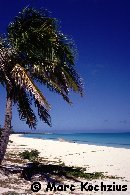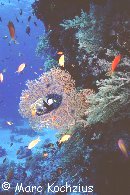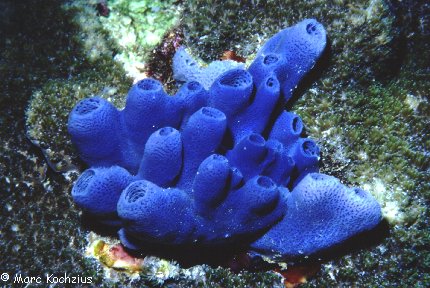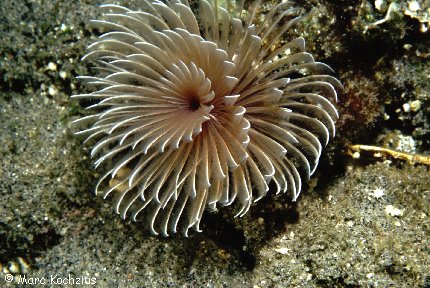|

Lagoon in
New Caledonia |
Living Water Filters
|

Coral reef in the
Red Sea |
|
"Brown sponges proliferate around the
basis of bright red gorgonians, which look like fragile fans, pasted over
by polyps like white stars... ... Everywhere tube worms show their colourful,
sometimes golden sprayed feather dusters..."
A. Francé-Harrar,South Seas.
Corals – Jungle – Cannibals (1928) |
|
|
Filter feeders
The marine food web starts with floating
plankton; tiny unicellular algae which produce with the help of sunlight,
carbon hydrates (= sugar) out of water and carbon dioxide. These algae
are eaten by zooplankton, tiny crustaceans, jellyfish as well as larvae
of fishes, corals, mussels and snails. Many sessile animals of coral reefs
filter plant and animal plankton out of the water:
- sponges
- ascidians
- mussels
- feather stars
- tube worms - cnidarians |

Water filter; Haliclona sp., a sponge |
|
|

Vacuum cleaners; ascidians |
Vacuum cleaners
Sponges are the most simple multicellular
animals. They do not have any organs, but are able to suck in water. A
football-sized sponge pumps about 3,000 l of water each day through its
body.
Ascidians show a more complicated structure,
but use the same mechanism like sponges. They suck in water and feed on
filtered plankton. |
|
|
Fans
Feather stars use another trick to catch
plankton; they settle at places in the reef that are exposed to currents.
They open their feathery arms mainly at night into the current to catch
plankton and bits of organic debris. These food particles are covered by
a sticky substance and are conveyed to the mouth by the motion of tiny
hairs that line special food gutters.
Tube worms spread their feather dusters
to filter food. When in danger, they withdraw with lightning speed into
their tube. |

Fan of a tube worm |
|

back |
|

next |
© Marc Kochzius |
|